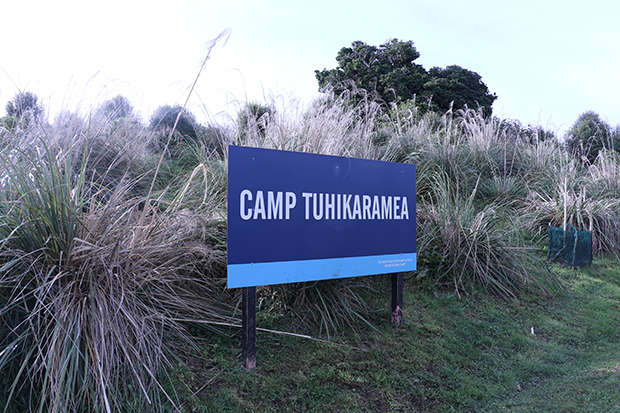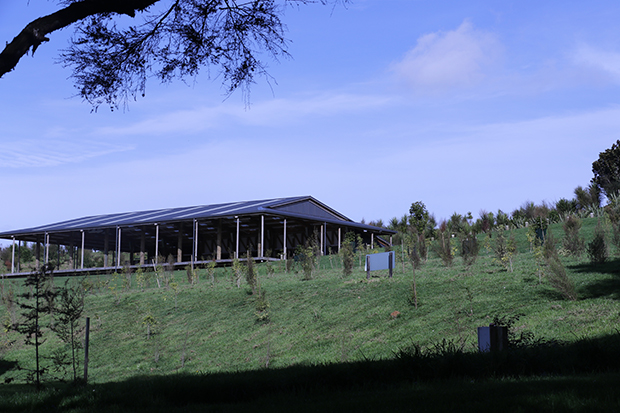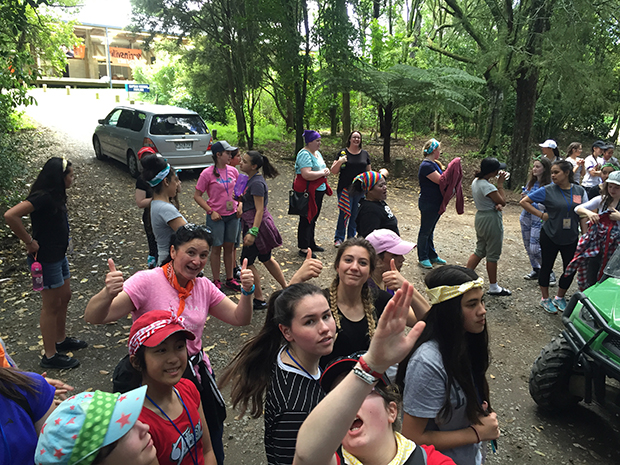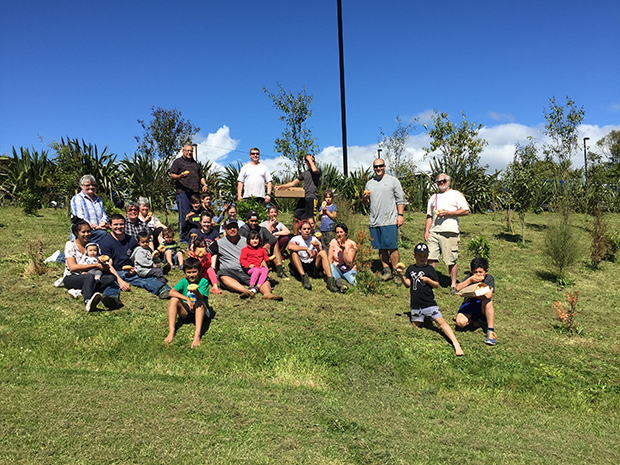Camp Tuhikaramea Offers Members in New Zealand a Unique Camping Experience
Contributed By Rachel Sterzer, Church News contributor

A sign posted near the entrance of Camp Tuhikaramea shows a map of the campsite. Photo by Rachel Sterzer.
Article Highlights
- Camp Tuhikaramea opened in 2015 and hosted over 8,000 visitors in 2016.
- The camp makes use of land cultivated and cared for by Church members and conservationist Roger Hamon.
“You can tell that [the campers’] hearts have been touched, and to us that’s our mission: to have the youth leave knowing that their Heavenly Father loves them.” —Aimee Rudd, missionary and director of Camp Tuhikaramea
Related Links
HAMILTON, NEW ZEALAND
More than 40 years ago, Church member and conservationist Roger Hamon approached a local farmer about purchasing a plot of land about a mile from the Hamilton New Zealand Temple.
At the time, the area was choked with gorse—an invasive New Zealand weed—and much of the native flora was being destroyed by possums and cattle.
Slowly, day by day, tree by tree, weed by weed, Hamon began cultivating the native plant life and developing paths, walkways, and other areas. Over time, people started coming from great distances to see the beauty of “Roger’s Bush.”
The work of Roger Hamon and his family made it possible for the Church to develop the area into a recreational campsite in 2012. After a construction period, the camp was dedicated on August 1, 2015. Today, Camp Tuhikaramea offers recreation facilities to wards, stakes, and LDS families throughout New Zealand.
A different kind of mission
The story of Roger Hamon is one that Elder David Rudd and his wife, Sister Aimee Rudd, love to share with new visitors to the camp. The missionary couple serves as the directors and caretakers for the site. For them, Hamon’s story shows “the amazing impact one person can have,” Elder Rudd said.
Serving at the Church’s recreational camp in New Zealand has been a unique experience for the missionary couple from Sandy, Utah. Instead of wearing traditional missionary attire—a shirt collar and tie for Elder Rudd and a dress or skirt for Sister Rudd—most days they settle for jeans and a pair of sturdy work boots. Instead of proselyting or going to people’s homes to teach, the two spend their days cutting down trees, planting trees, mowing lawns, and seeing to the maintenance of the camp’s facilities, which are extensive.
“I’ve logged hundreds of hours with the weed whacker,” Sister Rudd said with a laugh.
Continuing Hamon’s dream
The 40-acre property is home to nine campsites, all of which are named for individuals found in the Book of Mormon. Some sites have cabins while others are tent friendly. There are two large pavilions, equipped with kitchens in addition to tables, chairs, a piano, a sound system, and a television screen. There are also three smaller amphitheaters, two sets of shower and toilet facilities, and a sports field stocked with gear to play volleyball, cricket, baseball, and other activities.
The site also includes areas of dense vegetation, full of native trees, ferns, shrubs, and other plants in addition to two small lakes and a spring that feeds a few small ponds. Pathways and trails wind through the dense “bush,” or forested areas. The camp also retains its own greenhouse, where seedlings for plants and trees are cultivated to later be planted throughout the site. Roger Hamon, Elder Rudd explained, was passionate about only using vegetation native to New Zealand.
The upkeep for the 40-acre site is more than two people can keep up with, so they ask every group that visits to donate two hours of service. The wards from the local stakes also take turns sending volunteers each Saturday to provide a couple of hours of service. With the help of volunteers, the Rudds estimate they’ve planted about 5,000 trees during their tenure. Tens of thousands more will be planted in the next several years.
A new Waters of Mormon
In 2016, the camp hosted roughly 8,000 visitors. “Which is fantastic considering the camp is still relatively unknown,” Sister Rudd said. Although the Rudds said they are eager to see that number grow, Elder Rudd admitted, “at the end of the school holidays, we’re just exhausted. But we love it.”
“It’s so fun!” Sister Rudd added.
Their favorite part of their service has been the opportunity to interact with the youth and faithful members from throughout New Zealand, many of whom stay at the camp because of its close proximity to the temple.
The Rudds will often stand on the deck of the managers’ home and wave to visitors as they arrive and again as they depart. Sister Rudd said it’s amazing to see the change in people’s countenances, especially the youth. “You can tell that hearts have been touched, and to us that’s our mission: to have the youth leave knowing that their Heavenly Father loves them.”
Elder Dale G. Renlund of the Quorum of the Twelve Apostles recently visited the camp, and during his tour Sister Rudd tried to explain how their mission was a little different than most. Elder Renlund responded by comparing the camp to the Waters of Mormon in the Book of Mormon, where the Nephites went to be taught and feel the Spirit.
“That’s what we’re attempting to create,” Elder Rudd added, “a type of the Waters of Mormon. We’re creating an atmosphere where [visitors] can be close to the Spirit.”

A sign welcomes visitors to Camp Tuhikaramea, a recreation area for LDS youth, young adults, and families located within walking distance of the Hamilton New Zealand Temple. Photo by Rachel Sterzer.

One of two large pavilions found on the grounds of the Church-run Camp Tuhikaramea in Hamilton, New Zealand. Photo by Rachel Sterzer.

The 40-acre site for Camp Tuhikaramea includes areas of dense vegetation in addition to two small lakes and a spring that feeds a few small ponds. The Church-run camp offers recreation facilities to wards, stakes, and LDS families throughout New Zealand. Photo by Rachel Sterzer.

The Hamilton New Zealand Temple can be seen from the grounds of Camp Tuhikaramea, a recreation area for LDS youth, young adults, and families. Photo by Rachel Sterzer.

A sign posted near the entrance of Camp Tuhikaramea shows a map of the campsite. Photo by Rachel Sterzer.

The 40-acre site for Camp Tuhikaramea includes nine campsites, some of which offer cabins while others are tent friendly. The Church-run camp offers recreation facilities to wards, stakes, and LDS families throughout New Zealand. Photo by Rachel Sterzer.

Elder David Rudd, who serves as a director and caretaker for Camp Tuhikaramea, shows one of the pavilions equipped with kitchen facilities that can accommodate large groups at the Church-run camp. Photo by Rachel Sterzer.

One of the nine campsites—all of which are named for individuals found in the Book of Mormon—found at Camp Tuhikaramea, a recreation area for LDS youth, young adults, and families. Photo by Rachel Sterzer.

The greenhouse found at Camp Tuhikaramea in Hamilton, New Zealand, cultivates native plants to be used throughout the 40-acre recreation area. Photo by Rachel Sterzer.

The greenhouse found at Camp Tuhikaramea in Hamilton, New Zealand, cultivates native plants to be used throughout the 40-acre recreation area. Photo by Rachel Sterzer.

Elder David Rudd and Sister Aimee Rudd stand near a monument dedicated to Roger Hamon, who began cultivating the land that would later become Camp Tuhikaramea. Photo by Rachel Sterzer.

Sister Aimee Rudd shows the underside of the silver fern, one of the plants native to New Zealand found throughout the forested areas of Camp Tuhikaramea. The Church-run camp offers recreation facilities to wards, stakes, and LDS families throughout New Zealand. Photo by Rachel Sterzer.

Elder David Rudd and Sister Aimee Rudd, service missionaries who serve as the directors and caretakers of Camp Tuhikaramea, walk along the walkways winding through the native bush found throughout the camp. Photo by Rachel Sterzer.

One of the groves found within the dense forest areas of Camp Tuhikaramea in Hamilton, New Zealand. The Church-run camp offers recreation facilities to wards, stakes, and LDS families throughout New Zealand. Photo by Rachel Sterzer.

The 40-acre site for Camp Tuhikaramea includes nine campsites, some of which offer cabins while others are tent friendly. The Church-run camp offers recreation facilities to wards, stakes, and LDS families throughout New Zealand. Photo by Rachel Sterzer.

Youth from the Greerton Ward, Tauranga New Zealand Stake, provide service at Camp Tuhikaramea, a recreation area for LDS youth, young adults, and families. Photo courtesy of David Rudd.

LDS youth from Christchurch, New Zealand, gather on the sports field of Camp Tuhikaramea, a recreation area for LDS youth, young adults, and families. Photo courtesy of David Rudd.

Young women from the Hamilton New Zealand Glenview Stake gather at Camp Tuhikaramea for girls camp. Photo courtesy of David Rudd.

Young women from the Hamilton New Zealand Glenview Stake gather in a pavilion during their girls camp held at Camp Tuhikaramea. Photo courtesy of David Rudd.

Members of the Ngaruawahia Ward, Hamilton New Zealand Stake, provide service at Camp Tuhikaramea, a recreation area located within a mile of the temple. Photo courtesy of David Rudd.
